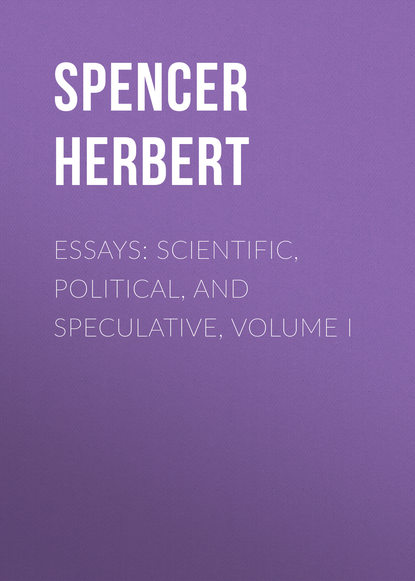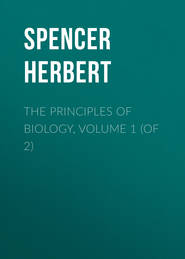По всем вопросам обращайтесь на: info@litportal.ru
(©) 2003-2024.
✖
Essays: Scientific, Political, and Speculative, Volume I
Настройки чтения
Размер шрифта
Высота строк
Поля
notes
1
Carpenter, Principles of Comparative Physiology, p. 474.
2
Since this was written (in 1857) the advance of paleontological discovery, especially in America, has shown conclusively, in respect of certain groups of vertebrates, that higher types have arisen by modifications of lower; so that, in common with others, Prof. Huxley, to whom the above allusion is made, now admits, or rather asserts, biological progression, and, by implication, that there have arisen more heterogeneous organic forms and a more heterogeneous assemblage of organic forms.
3
For detailed proof of these assertions see essay on "Manners and Fashion."
4
The argument concerning organic evolution contained in this paragraph and the one preceding it, stands verbatim as it did when first published in the Westminster Review for April, 1857. I have thus left it without the alteration of a word that it may show the view I then held concerning the origin of species. The sole cause recognized is that of direct adaptation of constitution to conditions consequent on inheritance of the modifications of structure resulting from use and disuse. There is no recognition of that further cause disclosed in Mr. Darwin's work, published two and a half years later – the indirect adaptation resulting from the natural selection of favourable variations. The multiplication of effects is, however, equally illustrated in whatever way the adaptation to changing conditions is effected, or if it is effected in both ways, as I hold. I may add that there is indicated the view that the succession of organic forms is not serial but proceeds by perpetual divergence and re-divergence – that there has been a continual "divergence of many races from one race": each species being a "root" from which several other species branch out; and the growth of a tree being thus the implied symbol.
5
"Personal Narrative of the Origin of the Caoutchouc, or India-Rubber Manufacture in England." By Thomas Hancock.
6
Carpenter's Principles of Comparative Physiology, pp. 616-17.
7
With the exception, perhaps, of the Myxinoid fishes, in which what is considered as the nasal orifice is single, and on the median line. But seeing how unusual is the position of this orifice, it seems questionable whether it is the true homologue of the nostrils.
8
In the Westminster Review for April, 1857; and now reprinted in this volume.
9
See Essay on "Progress: its Law and Cause."
10
This was written before the publication of the Origin of Species. I leave it standing because it shows the stage of thought then arrived at.
11
Cosmos. (Seventh Edition.) Vol. i. pp. 79, 80.
12
Since the publication of this essay the late Mr. R. A. Proctor has given various further reasons for the conclusion that the nebulæ belong to our own sidereal system. The opposite conclusion, contested throughout the foregoing section, has now been tacitly abandoned.
13
Any objection made to the extreme tenuity this involves, is met by the calculation of Newton, who proved that were a spherical inch of air removed four thousand miles from the Earth, it would expand into a sphere more than filling the orbit of Saturn.
14
A reference may fitly be made here to a reason given by Mons. Babinet for rejection of the Nebular Hypothesis. He has calculated that taking the existing Sun, with its observed angular velocity, its substance, if expanded so as to fill the orbit of Neptune, would have nothing approaching the angular velocity which the time of revolution of that planet implies. The assumption he makes is inadmissible. He supposes that all parts of the nebulous spheroid when it filled Neptune's orbit, had the same angular velocities. But the process of nebular condensation as indicated above, implies that the remoter flocculi of nebulous matter, later in reaching the central mass, and forming its peripheral portions, will acquire, during their longer journeys towards it, greater velocities. An inspection of one of the spiral nebulæ, as 51st or 99th Messier, at once shows that the outlying portions when they reach the nucleus, will form an equatorial belt moving round the common centre more rapidly than the rest. Thus the central parts will have small angular velocities, while there will be increasing angular velocities of parts increasingly remote from the centre. And while the density of the spheroid continues small, fluid friction will scarcely at all change these differences.
A like criticism may, I think, be passed on an opinion expressed by Prof. Newcomb. He says: – "When the contraction [of the nebulous spheroid] had gone so far that the centrifugal and attracting forces nearly balanced each other at the outer equatorial limit of the mass, the result would have been that contraction in the direction of the equator would cease entirely, and be confined to the polar regions, each particle dropping, not towards the sun, but towards the plane of the solar equator. Thus, we should have a constant flattening of the spheroidal atmosphere until it was reduced to a thin flat disk. This disk might then separate itself into rings, which would form planets in much the same way that Laplace supposed. But there would probably be no marked difference in the age of the planets." (Popular Astronomy, p. 512.) Now this conclusion assumes, like that of M. Babinet, that all parts of the nebulous spheroid had equal angular velocities. If, as above contended, it is inferable from the process by which a nebulous spheroid was formed, that its outer portions revolved with greater angular velocities than its inner; then the inference which Prof. Newcomb draws is not necessitated.
15
It is true that since this essay was written reasons have been given for concluding that comets consist of swarms of meteors enveloped in aeriform matter. Very possibly this is the constitution of the periodic comets which, approximating their orbits to the plane of the Solar System, form established parts of the System, and which, as will be hereafter indicated, have probably a quite different origin.
16
Though this rule fails at the periphery of the Solar System, yet it fails only where the axis of rotation, instead of being almost perpendicular to the orbit-plane, is very little inclined to it; and where, therefore, the forces tending to produce the congruity of motions were but little operative.
17
It is true that, as expressed by him, these propositions of Laplace are not all beyond dispute. An astronomer of the highest authority, who has favoured me with some criticisms on this essay, alleges that instead of a nebulous ring rupturing at one point, and collapsing into a single mass, "all probability would be in favour of its breaking up into many masses." This alternative result certainly seems the more likely. But granting that a nebulous ring would break up into many masses, it may still be contended that, since the chances are infinity to one against these being of equal sizes and equidistant, they could not remain evenly distributed round their orbit. This annular chain of gaseous masses would break up into groups of masses; these groups would eventually aggregate into larger groups; and the final result would be the formation of a single mass. I have put the question to an astronomer scarcely second in authority to the one above referred to, and he agrees that this would probably be the process.
18
The comparative statement here given differs, slightly in most cases and in one case largely, from the statement included in this essay as originally published in 1858. As then given the table ran thus: —
The calculations ending with these figures were made while the Sun's distance was still estimated at 95 millions of miles. Of course the reduction afterwards established in the estimated distance, entailing, as it did, changes in the factors which entered into the calculations, affected the results; and, though it was unlikely that the relations stated would be materially changed, it was needful to have the calculations made afresh. Mr. Lynn has been good enough to undertake this task, and the figures given in the text are his. In the case of Mars a large error in my calculation had arisen from accepting Arago's statement of his density (0·95), which proves to be something like double what it should be. Here a curious incident may be named. When, in 1877, it was discovered that Mars has two satellites, though, according to my hypothesis, it seemed that he should have none, my faith in it received a shock; and since that time I have occasionally considered whether the fact is in any way reconcilable with the hypothesis. But now the proof afforded by Mr. Lynn that my calculation contained a wrong factor, disposes of the difficulty – nay, changes the objection to a verification. It turns out that, according to the hypothesis, Mars ought to have satellites; and, further, that he ought to have a number intermediate between 1 and 4.
19
Since this paragraph was first published, the discovery that Mars has two satellites revolving round him in periods shorter than that of his rotation, has shown that the implication on which Laplace here insists is general only, and not absolute. Were it a necessary assumption that all parts of a concentrating nebulous spheroid revolve with the same angular velocities, the exception would appear an inexplicable one; but if, as suggested in a preceding section, it is inferable from the process of formation of a nebulous spheroid, that its outer strata will move round the general axis with higher angular velocities than the inner ones, there follows a possible interpretation. Though, during the earlier stages of concentration, while the nebulous matter, and especially its peripheral portions, are very rare, the effects of fluid-friction will be too small to change greatly such differences of angular velocities as exist; yet, when concentration has reached its last stages, and the matter is passing from the gaseous into the liquid and solid states, and when also the convection-currents have become common to the whole mass (which they probably at first are not), the angular velocity of the peripheral portion will gradually be assimilated to that of the interior; and it becomes comprehensible that in the case of Mars the peripheral portion, more and more dragged back by the internal mass, lost part of its velocity during the interval between the formation of the innermost satellite and the arrival at the final form.
20
I was about to suppress part of the above paragraph, written before the science of solar physics had taken shape, because of certain physical difficulties which stand in the way of its argument, when, on looking into recent astronomical works, I found that the hypothesis it sets forth respecting the Sun's structure has kinships to the several hypotheses since set forth by Zöllner, Faye, and Young. I have therefore decided to let it stand as it originally did.
The contemplated partial suppression just named, was prompted by recognition of the truth that to effect mechanical stability the gaseous interior of the Sun must have a density at least equal to that of the molten shell (greater, indeed, at the centre); and this seems to imply a specific gravity higher than that which he possesses. It may, indeed, be that the unknown elements which spectrum analysis shows to exist in the Sun, are metals of very low specific gravities, and that, existing in large proportion with other of the lighter metals, they may form a molten shell not denser than is implied by the facts. But this can be regarded as nothing more than a possibility.
No need, however, has arisen for either relinquishing or holding but loosely the associated conclusions respecting the constitution of the photosphere and its envelope. Widely speculative as seemed these suggested corollaries from the Nebular Hypothesis when set forth in 1858, and quite at variance with the beliefs then current, they proved to be not ill-founded. At the close of 1859, there came the discoveries of Kirchhoff, proving the existence of various metallic vapours in the Sun's atmosphere.
21
Of course there remains the question whether, before the stage here recognized, there had already been produced a high temperature by those collisions of celestial masses which reduced the matter to a nebulous form. As suggested in First Principles (§ 136 in the edition of 1862, and § 182 in subsequent editions), there must, after there have been effected all those minor dissolutions which follow evolutions, remain to be effected the dissolutions of the great bodies in and on which the minor evolutions and dissolutions have taken place; and it was argued that such dissolutions will be, at some time or other, effected by those immense transformations of molar motion into molecular motion, consequent on collisions: the argument being based on the statement of Sir John Herschel, that in clusters of stars collisions must inevitably occur. It may, however, be objected that though such a result may be reasonably looked for in closely aggregated assemblages of stars, it is difficult to conceive of its taking place throughout our Sidereal System at large, the members of which, and their intervals, may be roughly figured as pins-heads 50 miles apart. It would seem that something like an eternity must elapse before, by ethereal resistance or other cause, these can be brought into proximity great enough to make collisions probable.
22
The two sentences which, in the text, precede the asterisk, I have introduced while these pages are standing in type: being led to do so by the perusal of some notes kindly lent to me by Prof. Dewar, containing the outline of a lecture he gave at the Royal Institution during the session of 1880. Discussing the conditions under which, if "our so-called elements are compounded of elemental matter", they may have been formed, Prof. Dewar, arguing from the known habitudes of compound substances, concludes that the formation is in each case a function of pressure, temperature, and nature of the environing gases.
23











